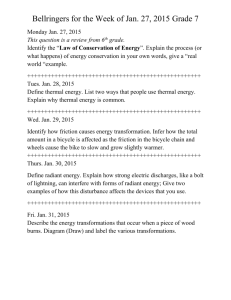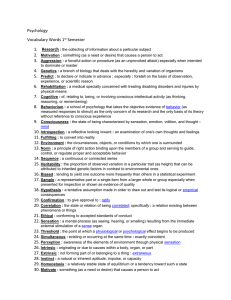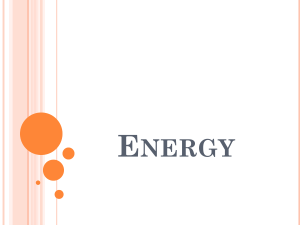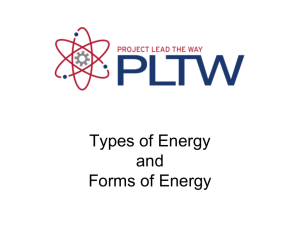Parametric Studies for Thermal Comfort Through the Use of Radiant
advertisement
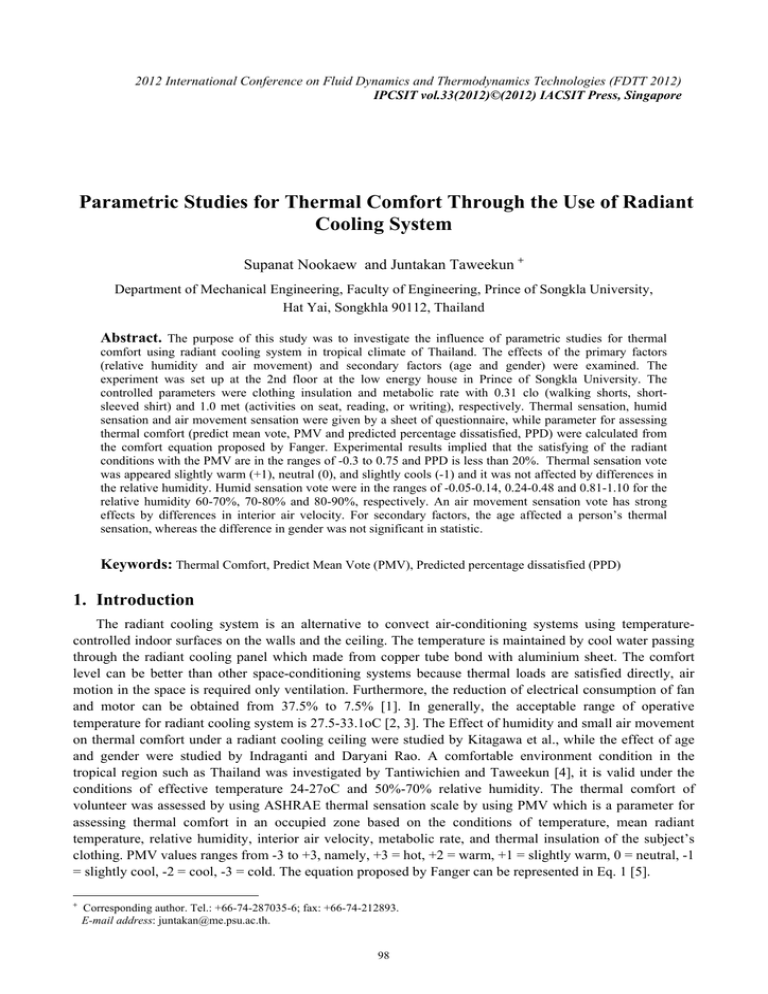
2012 International Conference on Fluid Dynamics and Thermodynamics Technologies (FDTT 2012) IPCSIT vol.33(2012)©(2012) IACSIT Press, Singapore Parametric Studies for Thermal Comfort Through the Use of Radiant Cooling System Supanat Nookaew and Juntakan Taweekun + Department of Mechanical Engineering, Faculty of Engineering, Prince of Songkla University, Hat Yai, Songkhla 90112, Thailand Abstract. The purpose of this study was to investigate the influence of parametric studies for thermal comfort using radiant cooling system in tropical climate of Thailand. The effects of the primary factors (relative humidity and air movement) and secondary factors (age and gender) were examined. The experiment was set up at the 2nd floor at the low energy house in Prince of Songkla University. The controlled parameters were clothing insulation and metabolic rate with 0.31 clo (walking shorts, shortsleeved shirt) and 1.0 met (activities on seat, reading, or writing), respectively. Thermal sensation, humid sensation and air movement sensation were given by a sheet of questionnaire, while parameter for assessing thermal comfort (predict mean vote, PMV and predicted percentage dissatisfied, PPD) were calculated from the comfort equation proposed by Fanger. Experimental results implied that the satisfying of the radiant conditions with the PMV are in the ranges of -0.3 to 0.75 and PPD is less than 20%. Thermal sensation vote was appeared slightly warm (+1), neutral (0), and slightly cools (-1) and it was not affected by differences in the relative humidity. Humid sensation vote were in the ranges of -0.05-0.14, 0.24-0.48 and 0.81-1.10 for the relative humidity 60-70%, 70-80% and 80-90%, respectively. An air movement sensation vote has strong effects by differences in interior air velocity. For secondary factors, the age affected a person’s thermal sensation, whereas the difference in gender was not significant in statistic. Keywords: Thermal Comfort, Predict Mean Vote (PMV), Predicted percentage dissatisfied (PPD) 1. Introduction The radiant cooling system is an alternative to convect air-conditioning systems using temperaturecontrolled indoor surfaces on the walls and the ceiling. The temperature is maintained by cool water passing through the radiant cooling panel which made from copper tube bond with aluminium sheet. The comfort level can be better than other space-conditioning systems because thermal loads are satisfied directly, air motion in the space is required only ventilation. Furthermore, the reduction of electrical consumption of fan and motor can be obtained from 37.5% to 7.5% [1]. In generally, the acceptable range of operative temperature for radiant cooling system is 27.5-33.1oC [2, 3]. The Effect of humidity and small air movement on thermal comfort under a radiant cooling ceiling were studied by Kitagawa et al., while the effect of age and gender were studied by Indraganti and Daryani Rao. A comfortable environment condition in the tropical region such as Thailand was investigated by Tantiwichien and Taweekun [4], it is valid under the conditions of effective temperature 24-27oC and 50%-70% relative humidity. The thermal comfort of volunteer was assessed by using ASHRAE thermal sensation scale by using PMV which is a parameter for assessing thermal comfort in an occupied zone based on the conditions of temperature, mean radiant temperature, relative humidity, interior air velocity, metabolic rate, and thermal insulation of the subject’s clothing. PMV values ranges from -3 to +3, namely, +3 = hot, +2 = warm, +1 = slightly warm, 0 = neutral, -1 = slightly cool, -2 = cool, -3 = cold. The equation proposed by Fanger can be represented in Eq. 1 [5]. + Corresponding author. Tel.: +66-74-287035-6; fax: +66-74-212893. E-mail address: juntakan@me.psu.ac.th. 98 PMV = [0.303exp [(-0.036 × M + 0.028 × L)]] (1) 2 Where PMV is predict mean vote. M is rate of metabolic heat production (W/m ) and L is the thermal load on the body (W/m2). Furthermore, the equation for PPD is given by Eq. 2. PPD is used to estimate the thermal comfort satisfaction of the occupant. PPD = 100 – 95exp [-(0.03353 × PMV4 + 0.2179 × PMV2)] (2) The operative temperature is the uniform surface temperature of an imaginary black enclosure in which an occupant would exchange the same amount of heat by radiation plus convection as in the actual non uniform environment as given in the following equation. To = hrTr + hcTa hr + hc (3) Where To, Tr and Ta are operative temperature, mean radiant temperature and indoor air temperature in units of oC, respectively. Values of hr and hc are surface radiation heat transfer coefficient and surface convection heat transfer coefficient in units of W/m2.K, respectively. In this study, the experiment was set up at the 2nd floor of the low energy house in Prince of Songkla University locating in the Southern part of Thailand which the operative temperature was between 27.2 to 30.2oC. The influences of parametric studies for thermal comfort included the primary factors i.e. relative humidity and air movement, and secondary factors i.e. age and gender were examined. Thermal sensation, humid sensation and air movement sensation were investigated by subjective experiment, while parameter for assessing thermal comfort (PMV and PPD) was evaluated by using the standard ISO 7730 [6] and ASHRAE 55-2004 [7]. 2. Methodology The radiant cooling system in this study was designed using cool water supplied from cooling tower passing through the radiant cooling panels which made from copper tube bond with aluminium sheet. The total floor area of the experiment room is 19.25 m2 and height 2.8 m. The cooling panels were installed at the ceiling and three sides of the opaque walls in the experimental room. The area of the ceiling and wall radiant cooling panels are 16.83 m2 and 11.89 m2, respectively. Temperature and humidity sensors were installed at the interior and exterior of the experimental room to measure the temperature and relative humidity of interior and exterior air. Surface temperatures of opaque wall and radiant cooling panels were measured by using thermocouple type K. Radiant temperature was also recorded using globe thermometer. Moreover, the interior air speed was measured using anemometer. Before starting an experiment, cold water from cooling tower was circulated to the cooling panel in order to maintain the operative temperature between 27.2-30.2oC. In the experiment, each volunteer was given a sheet of questionnaire. During the exposure period of three hours, the subject made three votes for thermal sensation, humid sensation and air movement sensation as shown in Table 1. The controlled parameters were clothing insulation and metabolic rate with 0.31 clo and 1.0 met, respectively. The effects of parametric studies included the primary factors (relative humidity and air movement) and secondary factors (age and gender). In the primary factors, the relative humidity (RH) was kept in the ranges of 60-70%, 70-80% and 80-90% by using dehumidifier, and the interior air velocity around the body (V) was varied at 0.4, 0.8, 1.0 and 1.2 m/s by a ventilation fan. The subjects were examined in two ranges, namely, ages more than 25 years old and less than 25 years old. Table 1 Voting scales for thermal sensation, humid sensation and air movement sensation Thermal sensation Humid sensation Air movement sensation +3 +2 +1 0 -1 -2 -3 hot warm slightly warm neutral slightly cool cool cold +2 +1 0 -1 -2 humid slightly humid just right slightly dry dry 99 4 3 2 1 too breezy breezy just right too still 3. Results and discussions 3.1. PMV and PPD Evaluation Mean radiant temperature and operative temperature obtained from the experiment have linear relationship as shown in Fig.1. PPD as a function of PMV was shown in Fig.2. The assessing thermal comfort in an occupied zone implied that the PMV range between -0.3 to 0.75. As a consequence, the PPD was less than 20%. It was considered that satisfying thermal comfort occupant can be achieved at 80%. The values of PMV were in the ranges of -0.3-0.35 and -0.4-0.27 for relative humidity 60-70% and 70-80%, respectively which the values of PPD were less than 10%, whereas the values of PPD were more than 10% for relative humidity 80-90%. In short, the radiant cooling can be achieved occupants comfort for keeping relative humidity and air movement in the ranges of 60-80% and 0.2-0.8, respectively. Fig. 1: The radiant temperature and operative temperature Fig. 2: PPD as a function of PMV 3.2. Comfort assessment 3.2.1 Thermal sensation vote The thermal sensation votes by subjects were given in Table 2. Most of subjects voted for slightly warm (+1), neutral (0), and slightly cools (-1). Thermal sensation of vote “0” was illustrated in Fig. 3 which the relationship between the percentages of the subjects voting neutral for thermal sensation with the air movement and the relative humidity were varied 0.4-1.2 m/s and 60-90%, respectively. Results implied that relative humidity has a slightly effect to thermal sensation vote for all cases of varying relative humidity as shown in Fig.4. Table 2 Thermal sensation vote RH (%) Ta (ºC) Tr (ºC) To (ºC) V (m/s) Number of Thermal Sensation Vote -3 65±5 75±5 85±5 3 Percent of “0” vote Percent of “-1”to”1” Vote Mean vote 85.71 90.48 80.95 76.19 100 0.14 -0.24 -0.48 -0.76 -0.10 -2 -1 0 1 2 13 14 11 8 13 1 1 3 5 4 5 6 7 5 3 1 1 1 3 61.90 66.67 52.38 38.10 61.90 27.7 29.7 27.6 29.9 27.7 29.7 27.2 27.9 27.2 0.4 0.8 1.0 1.2 0.4 - - - 0.8 1 5 12 3 57.14 95.24 -0.19 30.0 28.9 29.8 1.0 1.2 2 3 7 10 10 8 2 47.62 38.10 90.48 85.71 -0.43 -0.76 28.0 27.7 27.9 0.4 3 11 7 52.38 100 0.19 30.2 30.0 30.2 0.8 1.0 1.2 7 7 10 10 9 7 4 2 2 47.62 42.86 33.33 100 85.71 90.48 -0.14 -0.52 -0.57 3 2 100 Fig. 3: Thermal sensation percent of vote “0” Fig. 4: Thermal sensation with variable interior air velocity 3.2.2 Humid sensation vote The relationship between the percentages of the subjects voting just right and interior air velocity was illustrated in Fig.5. The humid sensation of vote “0” was more than 80% with a range of 60-70%RH for interior air velocity lower than 1 m/s. The results of humid sensation vote were shown in Fig. 6 which it appeared in the ranges of -0.05-0.14, 0.24-0.48 and 0.81-1.10 for the relative humidity 60-70%, 70-80% and 80-90%, respectively. Furthermore, the superior comfort can be achieved in the range of relative humidity 60-80% because the evaporation of perspiration was slowed, and a sense of stuffiness occurs in high humidity (80-90%). Fig. 5: Humid sensation percent of vote “0” Fig. 6: Humid sensation with variable interior air velocity 3.2.3 Air movement sensation vote The air movement sensation votes by subjects were given in Table 3. Relationship between the percentages of the subjects voting just right (vote “2”) and interior air velocity for different relative humidity were given in Fig 7. The acceptable comfort was less than 60% for interior air velocity more than 0.8 m/s. The suitable condition can be obtained at interior air velocity 0.4 m/s. Air movement sensation vote by varying interior air velocity was shown in Fig. 8 which it appeared in the ranges of 1.9-3.19, 1.95-3.33 and 1.9-3.29 for the relative humidity 60-70%, 70-80% and 80-90%, respectively. The air movement sensation vote was strong affected by differences in the interior air velocity. 101 RH (%) Ta (ºC) Tr (ºC) To (ºC) V (m/s) 65±5 27.7 29.7 27.6 29.9 27.7 29.7 27.2 30.0 27.9 28.9 27.2 29.8 0.4 0.8 1.0 1.2 0.4 0.8 1.0 1.2 0.4 0.8 1.0 1.2 75±5 85±5 28.0 30.2 27.7 30.0 27.9 30.2 Table 3 Air movement sensation vote Number of Air movement Percent Sensation Vote of “2” 1 2 3 4 vote 3 2 4 17 15 5 4 18 11 3 2 15 14 4 3 Fig. 7: Air movement sensation percent of vote “2” 1 6 15 9 1 10 18 10 2 6 15 9 1 8 9 1 2 9 80.95 71.43 23.81 19.05 85.71 52.38 14.29 9.52 71.43 66.67 19.05 14.29 Percent of vote Mean vote 100 100 95.24 61.90 100 100 100 57.14 100 95.24 90.48 57.14 1.90 2.29 2.81 3.19 1.95 2.48 2.86 3.33 1.90 2.38 2.90 3.29 Fig. 8: Air movement sensation with variable interior air velocity 3.3. The effect of age The T-test for significance of the effect of age was performed for reliability. The value of probability (Pvalue less than 0.05) had significant in statistic. In this study, the results revealed that the thermal environments for older people (more than 25 years old) are different from those preferred by younger people (less than 25 years old). It also showed the probability values being lower than 0.001 (more than 99% confidence level). Relationship of subject’s age with thermal sensation means votes were -0.0667 (nearly neutral) and -0.652 (between neutral to slightly cool) for older people and younger people, respectively. This is due to the older people has lower metabolic rates than younger people. Moreover, this may be explained by the metabolism decreases slightly with age or the lower activity level of elderly people, who are normally sedentary for a greater part of the day. 3.4. The effect of gender The experiments showed that thermal sensation votes for men and women have slightly difference. The P-value is 0.156 which the effect of gender has no significant factor. The thermal sensation mean votes were -0.267 and -0.470 for male and female, respectively. In practice, women’s skin temperature and evaporative loss are slightly lower than those for men, and this balances the somewhat lower metabolism of women. 4. Conclusion The investigation of parametric studies included relative humidity, air velocity, age and gender on thermal comfort of radiant cooling system in tropical climate of Thailand have been proposed. Thermal 102 comfort was evaluated using thermal sensation, humid sensation and air movement sensation. Furthermore, PMV and PPD were also examined in this study. As a brief summary, the main findings can be summarized. The first of main findings, the assessing thermal comfort for the use of radiant cooling system implied that the PMV is in the range of -0.3 to 0.75 (PPD 20% of dissatisfied). The second, thermal sensation vote were appeared in three periods with slightly warm (+1), neutral (0), and slightly cools (-1) and it was not affected by differences in the relative humidity. For air movement sensation votes, it appeared 1.8-2.4 for air movement was the air velocity between 0.4-0.8 m/s. Moreover, the air movement sensation votes was not affected by differences in the relative humidity; while it was strong affected by differences in the air velocity. Finally, for secondary factors, the age was affected a person’s thermal sensation, whereas the difference in gender was not significant in statistic. 5. Acknowledgments This research was financially supported by the Energy Policy and Planning Office (EPPO), Ministry of Energy, Thailand and Prince of Songkla University for providing the research scholarships. 6. References [1] H.E. Feustel and C. Stetiu. Hydronic radiant cooling-preliminary assessment. Energy and Building. 1995, 22: 193205. [2] K. Kitagawa, N. Komoda, H. Hayano and S.Tanabe. Effect of humidity and small air movement on thermal comfort under a radiant cooling ceiling by subjective experiments. Energy and Buildings. 1999, 30: 185-193. [3] M. Indraganti and K. Daryani Rao. Effect of age, gender, economic group and tenure on thermal comfort: A field study in residential buildings in hot and dry climate with seasonal variations. Energy and Buildings. 2010, 42: 273-281. [4] A. Tantiwichien and J. Taweekun. Thermal comfort zone for Thai people. International Conference on Electrical Energy and Networks. 2012. [5] P.O. Fanger. Thermal Comfort. Copenhagen, Danish Technical Press, 1970. [6] ISO, International Standard 7730. Moderate thermal environment: determination of PMV and PPD Indies and specification of the conditions for thermal environment. International Organization for Standardization. Geneva, 1994. [7] ASHRAE, ANSI/ASHRAE Standard 55-2004. Thermal environmental conditions for human occupancy. ASHRAE, Inc., 2004. 103

